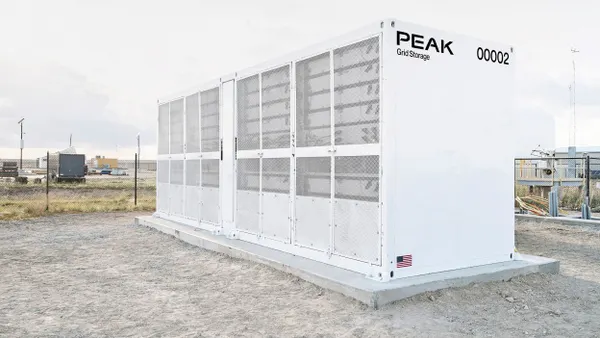The market for energy storage frequency regulation in the PJM Interconnection has had its ups and downs in the past year or two.
After an initial boom that began to overwhelm PJM’s frequency regulation market, the RTO put the brakes on battery storage installations. PJM quickly followed up by changing the parameters of its frequency regulation signal and then proposed further changes in how it calibrates the relationship between fast response resources, such as batteries, and conventional resources, such as gas turbines. Those changes were met with howls of protest by energy storage developers, some of who are contesting the changes at the Federal Energy Regulatory Commission.
In 2011, FERC issued Order 755, which called for more equitable treatment for fast responding resources, such as batteries, in the frequency regulation market. The PJM Interconnection implemented those rules in 2012, splitting its frequency regulation market into a fast ramping services, so-called RegD, and slower ramping service, or RegA. That resulted in a rush of energy storage projects in PJM.
Record year for storage
The rush was strong enough to push energy storage to a record year. There were 221 MW of energy storage projects installed nationwide in 2015, a 243% increase from 2014. By mid-year 2016, PJM had about 265 MW of grid-connected storage projects, of which about 160 MW were installed in 2015, and with about 700 MW more under construction or in development. The rush of projects also exposed some flaws in the design of PJM’s frequency regulation market. Sometimes a battery providing fast ramping frequency regulation service would be depleted and go from discharge to charging mode, burdening the grid instead of supporting it.
“The RegD signal would sometimes move in the opposite direction of the area control error [ACE], exacerbating the frequency regulation problem,” Eric Hsia, manager of performance compliance at PJM, told Utility Dive.
When that would happen, PJM would in effect be paying for RegA in order to cancel out the draw of RegD resources on the system.
RegD resources respond quickly to ACE signals, but are time limited. RegA resources respond to signals more slowly but do not have duration limits, so the technical trick is to find the optimal mix of RegD and RegA on the system. RegD has more value for quick response needs, but too much RegD and that benefit would be reversed and could even harm the grid.
PJM went through a two year stakeholder process to address the issue. In 2015, PJM imposed a cap on RegD resources, limiting them to no more than 26.2% of the regulation procurement during morning and afternoon ramp times. The cap was removed last month.
Energy neutrality goal
In January 2017, PJM re-engineered its frequency regulation signal in order to achieve “conditional neutrality” for RegD resources. The original goal for frequency regulation, set in accordance with Order 755, was for a regulation resource to be “energy neutral,” that is, to spend as much time pulling energy as providing energy. The signal was originally designed to converge on neutral within 15 minutes 95% of the time.
Under conditional neutrality, as PJM explains it, “the neutrality bias intentionally over-corrects with the Regulation A signal, such that Regulation D can move in the direction that reduces accumulated state of charge.”
In other words, the aim is that the signals for RegA and RegD will work together so that energy neutrality is only supported for RegD resources when there are available RegA resources with extra capacity. The new signal also expanded the time frame for RegD neutrality from 15 minutes to 30 minutes.
In February, PJM proposed changes to other components of its frequency regulation market. Specifically, PJM proposed replacing the “mileage ration” benefit factor curve with a Regulation Rate of Technical Substitution (RRTS). Those changes were endorsed by PJM’s Members Committee on July 27.
The mileage ratio was designed to compensate battery storage operators for wear and tear on their assets because frequent cycling can degrade a battery and shorten its expected life span. The benefit factor curve is used to gauge the optimal mix of RegA and RegD resources.
Storage developers challenge PJM changes
In April, energy storage developers filed complaints with FERC, alleging that PJM’s changes to its frequency regulation market, the cap and the revised signal, violate the Federal Power Act because they constitute tariff changes that must be approved by FERC, not implemented unilaterally.
PJM made the changes in January through a stakeholder process rather than through a FERC filing because the changes pertained to reliability control issues, not tariffs, Hsia said.
PJM is now preparing a filing at FERC under Section 205 of the Federal Power Act, which governs wholesale tariffs. The “tentative” filing date is late September, said Hsia.
The 205 filing will seek approval for the substitution of the mileage ratio and the benefit factor curve with the Regulation Rate of Technical Substitution, as well as changes to precision-only performance scoring. As a compromise to some stakeholders, the filing will also include a description of PJM’s regulation signal.
The parties in the complaints filed with FERC include the Energy Storage Association and, in a separate filing, RES Americas and Invenergy.
Project margins reduced 75%
In a July letter to PJM, AES Energy Storage said it designed its 20 MW Tait storage facility in Ohio and its 32 MW Laurel Mountain facility in West Virginia with PJM’s 15 minute design specifications in mind. AES says PJM’s December and January changes to the RegD market have reduced the 2016 margins for those projects by 75% compared with 2015 margins. In addition, AES says operating under the new rules “has greatly reduced the expected useful equipment life and seriously threatens the continued viability of these batteries.”
Those batteries are now “doing twice the work for half the revenues while shortening their remaining life,” AES said in the filing.
In the ESA complaint filed with FERC, Damien Buie, with EDF Renewable Energy, said the company’s 20 MW McHenry storage project in Illinois “has been significantly and detrimentally impacted by PJM’s January 9, 2017, decision.”
In a June presentation to PJM’s Markets and Reliability Committee, the ESA said there are 10 storage projects totaling about 285 MW that were designed to meet PJM’s original, 15 minute signal specifications.
The new, 30-minute signal might not be so much of a problem for early battery storage projects in PJM, which were in a position to earn back their investment quickly through a combination of high power prices and events such as the Polar Vortex, which caused power prices to spike, Daniel Finn-Foley, senior energy storage analyst at GTM Research, told Utility Dive. And developers who entered the market more recently could be able to design their projects to meet PJM’s new standards, but projects in the middle could face problems. Revenues for some of those projects have dropped as much as 70% or 80%, said Finn-Foley.
In a June report, Finn-Foley also noted that prices have cratered in PJM. From 2014 to 2016, they fell from about $43/MWh to around $15/MWh in March as a result of lower natural gas prices.
Storage projects dropping out
The result, said Finn-Foley, is that storage projects are dropping out of the interconnection queue. “We are seeing a handful drop off every quarter,” he said.
Finn-Foley said developers are “starting to dip their toes into other frequency regulation markets.
Outside of PJM and California, the frequency regulation market for energy storage has not opened up, said Matt Roberts, vice president of the ESA, but it is “starting to be leveraged in vertical markets for this service in addition to others.”
Roberts said the “big breakthrough” will most likely come from FERC’s notice of proposed rule making for energy storage issued late last year.
Other priorities for FERC
Meanwhile, FERC has a large backlog of cases to work through. The agency only returned to quorum last month with the Senate approval and the subsequent swearing in of Commissioners Neil Chatterjee and Robert Powelson. (Chatterjee was then appointed interim chairman of FERC by President Donald Trump.)
FERC does not have an official tally of its backlog, but FERC watchers say there are hundreds of pending cases. John Moore, director of the Sustainable FERC Project at the Natural Resources Defense Council, has said he expects FERC to issue more routine "bread and butter" orders before tackling more controversial issues.
Finn-Foley said he expects FERC to prioritize high profile cases that are in line with the Trump administration’s agenda, such as moving oil and gas pipeline projects forward. In that scenario it could be many months before FERC takes up the frequency regulation complaint.
The prospects of the frequency regulation market “all come to a head at FERC,” said Finn-Foley. “The industry needs FERC to step in and provide some clarity. PJM did that, and then they took it way.”
Frequency regulation will remain “a driving application” for energy storage, said Roberts, but many more applications are opening up around the country and “frequency regulation as a specific service will play a smaller role in energy storage markets in the future.”




















